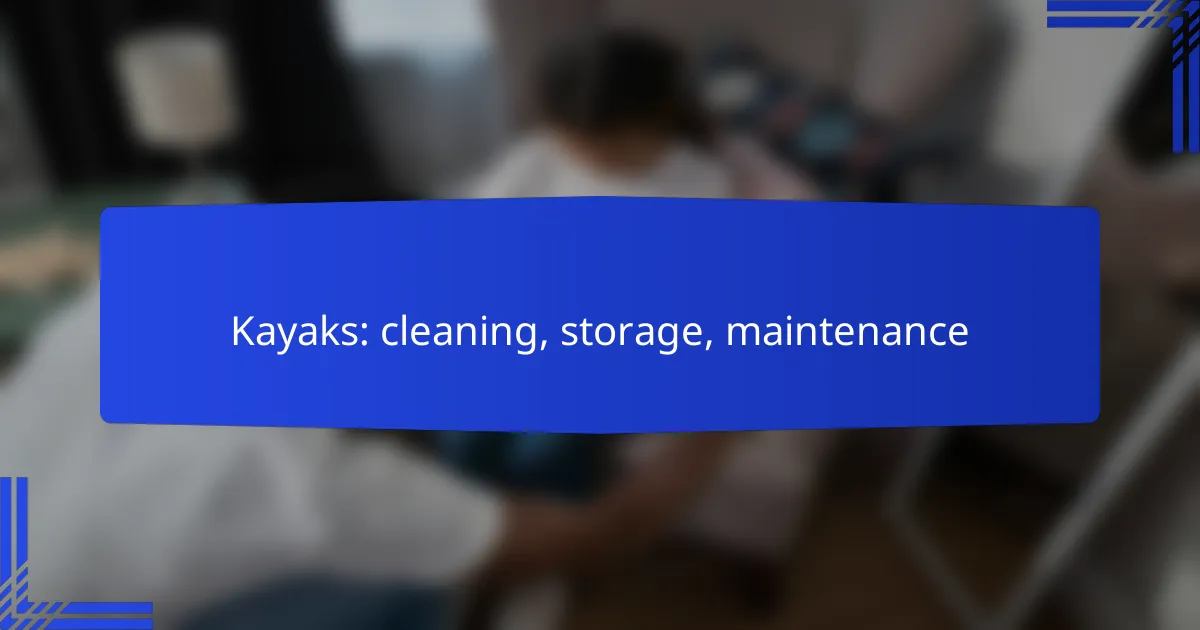Proper care of your kayak is essential for maintaining its performance and longevity. Regular cleaning, appropriate storage, and diligent maintenance can prevent damage from environmental factors and ensure your kayak remains in excellent condition for years to come. By following these straightforward practices, you can enjoy your paddling adventures with peace of mind.

How to clean kayaks in New Zealand?
Cleaning kayaks in New Zealand involves a few straightforward steps to ensure they remain in good condition. Regular maintenance helps prevent damage from saltwater, dirt, and algae, which are common in local waterways.
Freshwater rinse
Start by rinsing your kayak with freshwater as soon as possible after use. This is especially important if you have been in saltwater, as it helps remove salt deposits that can corrode the material over time.
A thorough rinse can be done with a hose or in a freshwater lake. Aim to rinse all surfaces, including the underside, to prevent buildup of grime and algae.
Use mild soap
After rinsing, apply a mild soap specifically designed for cleaning boats or kayaks. Avoid harsh chemicals that can damage the kayak’s material or finish.
Mix the soap with water in a bucket, and use a soft cloth or sponge to clean the kayak’s surface. This step helps remove any remaining dirt and prevents staining.
Soft brush application
For stubborn spots or areas with heavy algae growth, use a soft brush to gently scrub the affected areas. This will help lift off any debris without scratching the kayak’s surface.
Be cautious around sensitive areas like hatches and fittings, ensuring you don’t damage seals or attachments while cleaning.
Drying techniques
Once cleaned, allow your kayak to dry completely before storing it. Position it in a shaded area to prevent UV damage from direct sunlight, which can degrade the material over time.
Consider using a soft towel to wipe down any excess water, especially in crevices where moisture can accumulate. Proper drying helps prevent mold and mildew growth, ensuring your kayak stays in optimal condition.

What are the best storage practices for kayaks?
To ensure the longevity of your kayak, proper storage practices are essential. Storing your kayak in a suitable environment protects it from damage caused by weather, UV exposure, and physical impacts.
Indoor storage options
Indoor storage is ideal for protecting your kayak from the elements. Consider using a dedicated room, garage, or basement where the temperature and humidity are stable. Make sure the area is clean and free from sharp objects that could cause scratches.
When storing indoors, position the kayak on its side or upside down to prevent warping. If space allows, use a padded rack or hang it from the ceiling to save floor space and avoid contact with hard surfaces.
Outdoor storage solutions
If indoor storage isn’t feasible, outdoor options can still be effective. Choose a shaded area to minimize UV exposure, and consider using a waterproof cover to protect against rain and debris. Ensure the kayak is elevated off the ground to prevent moisture buildup.
Secure the kayak with straps or a lock to deter theft. Regularly check the condition of the cover and the kayak itself for any signs of wear or damage from the elements.
Using kayak racks
Kayak racks are a practical solution for both indoor and outdoor storage. They come in various designs, including wall-mounted, freestanding, and ceiling-mounted options, allowing you to choose one that fits your space and needs.
When selecting a rack, ensure it is sturdy enough to support the weight of your kayak. Look for racks with padding or protective features to prevent scratches. Regularly inspect the rack for stability and wear to maintain safety and effectiveness.

How to maintain kayaks for longevity?
Maintaining kayaks for longevity involves regular care and attention to detail. By following a few key practices, you can ensure your kayak remains in excellent condition and extends its lifespan significantly.
Regular inspections
Conducting regular inspections is crucial for kayak maintenance. Check for any signs of wear, damage, or leaks at least once a month, especially before and after use. Look closely at the hull, seams, and fittings to identify potential issues early.
During inspections, pay attention to the kayak’s hardware, including screws and handles. Tighten any loose parts and replace worn-out components to prevent further damage. Keeping a maintenance log can help track any repairs or replacements needed over time.
Repairing scratches
Scratches on your kayak can compromise its performance and durability. For minor scratches, use a fine-grit sandpaper to smooth the surface, then apply a marine-grade epoxy or repair kit specifically designed for kayaks. This will help seal the area and prevent water intrusion.
For deeper gouges, consider using a patch made from the same material as your kayak. Clean the area thoroughly before applying the patch with adhesive. Always follow the manufacturer’s instructions for the best results.
UV protection methods
Protecting your kayak from UV damage is essential for maintaining its integrity. Store your kayak in a shaded area or use a UV-resistant cover when not in use. This will help prevent fading and deterioration of the material.
Additionally, applying a UV protectant specifically designed for kayaks can provide an extra layer of defense. Regularly reapply this protectant according to the product instructions, especially after cleaning or exposure to harsh sunlight.

What are the essential kayak maintenance tools?
Essential kayak maintenance tools include cleaning supplies, repair kits, and storage accessories. These tools help ensure your kayak remains in good condition, enhancing its performance and longevity.
Cleaning supplies
To maintain your kayak, you need effective cleaning supplies. Basic items include a soft sponge or cloth, mild soap, and a brush with soft bristles for removing dirt and algae without scratching the surface.
Consider using a dedicated kayak cleaner that is environmentally friendly. This helps protect the water quality while ensuring your kayak is free from harmful residues.
Repair kits
A good repair kit is crucial for addressing minor damages. Essential items in a kayak repair kit typically include adhesive patches, a multi-tool, and a sealant for leaks.
When selecting a repair kit, ensure it is suitable for your kayak’s material, whether it’s plastic, fiberglass, or inflatable. Regularly check your kit to replace any used items and keep it ready for emergencies.
Storage accessories
Proper storage accessories help protect your kayak from damage when not in use. Consider investing in a kayak rack or wall mounts to keep it off the ground and prevent warping.
Additionally, use a breathable cover to shield your kayak from UV rays and debris. This can significantly extend its lifespan, especially if you store it outdoors.

How to prepare kayaks for seasonal changes?
Preparing kayaks for seasonal changes is essential to maintain their performance and longevity. This involves cleaning, storing, and performing maintenance tasks tailored to the specific season, particularly winter and summer.
Winterizing techniques
Winterizing your kayak is crucial to prevent damage from freezing temperatures and ice. Start by thoroughly cleaning the kayak to remove dirt, salt, and any organic materials that could cause corrosion or mold during storage.
Next, drain any water from the kayak and ensure that all compartments are dry. Apply a protective coating of wax or silicone to the exterior to shield it from moisture and UV damage. If your kayak has removable parts, such as seats or footrests, take them out and store them separately in a dry place.
Finally, store the kayak in a cool, dry location, ideally elevated off the ground to avoid moisture accumulation. Use a kayak cover to protect it from dust and potential pests during the winter months.
